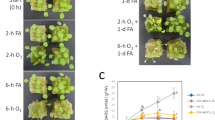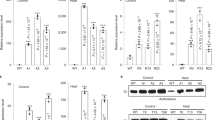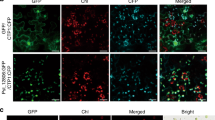Abstract
Transgenic tobacco plants that synthesize alfalfa ferritin in vegetative tissues—either in its processed form in chloroplasts or in the cytoplasmic nonprocessed form—retained photosynthetic function upon free radical toxicity generated by iron excess or paraquat treatment. Progeny of transgenic plants accumulating ferritin in their leaves exhibited tolerance to necrotic damage caused by viral (tobacco necrosis virus) and fungal (Alternaria alternata, Botrytis cinerea) infections. These transformants exhibited normal photosynthetic function and chlorophyll content under greenhouse conditions. We propose that by sequestering intracellular iron involved in generation of the very reactive hydroxyl radicals through a Fenton reaction, ferritin protects plant cells from oxidative damage induced by a wide range of stresses.
This is a preview of subscription content, access via your institution
Access options
Subscribe to this journal
Receive 12 print issues and online access
$209.00 per year
only $17.42 per issue
Buy this article
- Purchase on Springer Link
- Instant access to full article PDF
Prices may be subject to local taxes which are calculated during checkout




Similar content being viewed by others
References
Prince, A.H., Atherton, N.M., and Headry, G.A.F. 1989. Plant under drought–stress generate activated oxygen. Free Rad. Res. Commun. 8 :61–66.
Foyer, C.H., Descourviéres, P., and Kunert, K.J. 1994. Protection against oxygen radicals: an important defence mechanism studied in transgenic plants. Plant Cell Environ. 17:507– 523.
Hammond–Kosack, K.E. and Jones, J.D.G. 1996 . Resistance gene–dependent plant defense responses. The Plant Cell 8:1773–1791.
Lamb, C. and Dixon, R.A. 1997. The oxidative burst in plant disease resistance. Annu. Rev. Plant Physiol. and Plant Mol. Biol. 48:251–275.
Halliwell, B. and Gutteridge, J.M.C. 1986. Oxygen free radicals and iron in relation to biology and medicine: some problems and concepts. Arch. Biochem. Biophys. 246: 501–514.
Henle, E.S. and Linn, S. 1997. Formation, prevention, and repair of DNA damage by iron/hydrogene peroxide. J. Biol. Chem. 272:19095–19098.
Repine, J.E., Fox, R.B., and Berger, E. 1981. Hydrogene peroxide kills Staphylococcus aureus by reacting with staphylococcal iron to form hydroxil radicals. J. Biol. Chem. 256:7094– 7096.
Theil, E.C. 1987. Ferritin: structure, gene regulation, and cellular function in animals, plants, and microorganisms. Annu. Rev. Biochem. 56:289–315.
Lobréaux, S. and Briat, J–F. 1991. Ferritin accumulation and degradation in different organs of pea (Pisum sativum) during development. Biochem. J. 274:601–606.
Lobréaux, S. Hardy, T., and Briat, J–F. 1993. Abscisic acid is involved in the iron–induced synthesis of maize ferritin. EMBO J. 12:651–657.
Balla, Gy., Jacob, H.S., Balla, J., Rosenberg, M., Narth, K., Apple, F. et al. 1992. Ferritin: a cytoprotective antioxidant strategem of endothelium. J. Biol. Chem. 267:18148–18153.
Vile, G.F. and Tyrrell, R.M. 1993. Oxidative stress resulting from ultraviolet a irradiation of human skin fibroblasts leads to a heme oxygenase–dependent increase in ferritin. J. Biol. Chem. 268:14678–14681.
Cairo,G., Tacchini, L., Pogliaghi, G., Anzon, E., Tomasi, A., and Bernelli–Zazzera, A. 1995. Induction of ferritin synthesis by oxidative stress. Transcriptional and post–translational regulation by expansion of the free iron pool. J. Biol. Chem. 270:700–703.
Lobréaux, S., Yewdall, J.S., Briat, J–F., and Harrison, P.M. 1992. Amino acid sequence and predicted three–dimensional structure of pea seed (Pisum sativum) ferritin. Biochem. J. 288:931–939.
Kampfenkel, K.M., van Montagu, M., and Inzé, D. 1995. Effects of iron excess on nicotiana plumbaginifolia plants. Implications to oxidative stress. Plant Physiol. 107:725–735.
Babbs, C.E., Pham, J.A., and Coolbaugh, R.C. 1989. Lethal hydroxyl radical production in paraquat treated plants. Plant Physiol. 90:1267–1270.
Perl, A., Perl–Treves, R., Galili, S., Aviv, D., Shalgi, E., Malkin, S. et al. 1993. Enhanced oxidative stress defense in transgenic potato expressing tomato Cu, Zn superoxide dismutases. Theor. Appl. Genet. 85:568–576.
Barna, B., Ádám, A., and Király, Z. 1993. Juvenility and resistance of a superoxide–tolerant plant to diseases and other stresses. Naturwissenschaften 80:420– 422.
Vass I., Sass L., Spetea, C., Bakou, A., Ghanotakis, D.F., and Petrouleas, V. 1996. UV–B–induced inhibition of photosytem II electron transport studied by EPR and chlorophyll fluorescence. Impairment of donor and acceptor side components. Biochemistry 35:8964–8973.
Low, P. and Merida, J. 1996. The oxidative burst in plant defence: function and signal transduction. Physiol. Plant. 96:533–542.
Peng, M. and Kuc, J. 1992. Peroxidase–generated hydrogen peroxide as a source of antifungal activity in vitro and on tobacco leaf disks. Phytopathology. 82:696 –699.
Ouf, M.F., Gazar, A.A., Shehata, Z.A., Abdou, El S., Király, Z., and Barna, B. 1993. The effect of superoxide anion on germination and infectivity of wheat stem rust (Puccinia graminis Pers. f. sp. tritici Eriks. and Henn.) uredospores. Cereals Research Communications 21:31–37.
Király, Z., El–Zahaby, H., Gala, A., Abdou, S., Ádám, A., Barna, B. et al. 1993. Effect of oxygen free radicals on plant pathogenic bacteria and fungi and on some plant diseases, pp. 9–19, in Oxygen free radicals and scavengers in the natural sciences, Mózsik, Gy., Emerit, I., Fehér, J., Matkovics, B., and Vincze, Á. (eds.). Akadémiai Kiadó, Budapest, Hungary.
Elstner, E.F. 1982. Oxygen activation and oxygen toxicity. Ann. Rev. Plant Physiol. 33:73–96.
Sutherland, M.W. 1991. The generation of oxygen free radical during host plant response to infection. Physiol. Molec. Plant Pathol. 39:79–93.
Elstner, E.F. and Osswald, W. 1994. Mechanism of oxygen activation during plant stress, pp. 131– 154, in Oxygen and environmental stress in plants, Crawford, R.M.M., Hendry, G.A.F., and Goodman, B.A. (eds.). The Royal Society of Edinburgh, Edinburgh, Scotland.
Baker, C.J. and Orlandi, E.W. 1995. Active oxygen in plant pathogenesis. Ann. Rev. Phytopathol. 33:299–321.
Bowler, C., Slooten, L., Vanderbrande, S., De Rycke, R., Bottermann, J., Sybesma, C. et al. 1991. Manganese superoxide dismutase can reduce cellular damage mediated by oxygen radicals in transgenic plants. EMBO J. 10:1723– 1733.
Rennenberg, H. and Polle, A. 1994. Protection from oxidative stress in transgenic plants. Biochem. Soc. Trans. 22:936–940.
Allen, R. 1995. Dissection of oxidative stress tolerance using transgenic plants. Plant Physiol. 107:1049– 1054.
Mullineaux, P.M. and Creissen G.P. 1996 . Opportunities for the genetic manipulation of antioxidants in plant foods. Biochem. Soc. Trans. 24:829 –835.
Thomas, C.E. and Aust, S.D. 1986. Reductive release of iron from ferritin by cation free radicals of paraquat and other bipyridyls. J. Biol. Chem. 261:13064– 13070.
Zer, H., Peleg, I., and Chevion, M. 1994. The protective effect of desferrioxamine on paraquat–treated pea (Pisum sativum). Physiol. Plantarum. 92:437–442.
Fobis–Loisy, I., Loridon, K., Lobreaux, S., Lebrun, M., and Briat J.–F. 1995. Structure and differential expression of two maize ferritin genes in response to iron and abscisic acid. Eur. J. Biochem. 231: 609–619.
Bauminger E., Harrison P.M., Hechel D., Nowik I., and Treffry A. 1991. Mössbauer spectroscopic investigation of structure–function relations in ferritins. Biochim. Biophys. Acta. 1118:48–58.
Andrews, S.C., Arosio, P., Bottke, W., Briat, J–F., von Darl, M., Harrison, P.M. et al. 1992. Structure, function and evolution of ferritins. J. Inorg. Biochem. 47:161– 174.
Briat J.–F. and Lobreaux S. 1997 . Iron transport and storage in plants. Trends in Plant Sci. 2:187–193.
van Wuytswinkel, O., Savino, G., and Briat, J.F. 1995. Purification and characterisation of recombinant pea seed ferritins expressed in E. coli: influence of N–terminus deletion on protein solubility and core formation in vitro. Biochem J. 305:253–261.
Mitra, A. and Zhang, Z. 1994. Expression of human lactoferrin cDNA in tobacco cells produces antibacterial protein(s). Plant Physiol. 106:977– 981.
Claes, B., Smalle, J., Dekeyser, R., van Montagu, M., and Caplan, A. 1991. Organ–dependent regulation of a plant promoter isolated from rice by 'promoter–trapping' in tobacco. Plant J. 1:15–26.
Maes, M. and Messens, E. 1992. Phenol as grinding material in RNA preparations. Nucleic. Acids Res. 20:4374–4375.
Sambrook, J., Fritsch, F.F., and Maniatis, T., 1989. Molecular cloning: a laboratory manual. Cold Spring Harbor Laboratory Press, Cold Spring Harbor, NY.
Nechustai, R. and Nelson, N. 1985. Biogenesis of photosystem I reaction center during greening of oat, bean and spinach leaves. Plant. Mol. Biol. 4:377– 384.
Journet, E–P. 1987 Isolation of plastids from buds of cauliflower. Methods Enzymol. 148:234– 240.
Arnon, D. 1949. Copper enzymes in isolated chloroplasts. Polyphenol oxidase in Beta vulgaris. Plant Physiol. 24:1– 5.
Acknowledgements
The authors thank Keczánné Czakó Zsuzsa for the excellent work during the preparation of the manuscript. This work was supported by the Körber Foundation, Hamburg, Germany.
Author information
Authors and Affiliations
Corresponding author
Rights and permissions
About this article
Cite this article
Deák, M., Horváth, G., Davletova, S. et al. Plants ectopically expressing the ironbinding protein, ferritin, are tolerant to oxidative damage and pathogens. Nat Biotechnol 17, 192–196 (1999). https://doi.org/10.1038/6198
Received:
Accepted:
Issue Date:
DOI: https://doi.org/10.1038/6198
This article is cited by
-
Iron Induces Resistance Against the Rice Blast Fungus Magnaporthe oryzae Through Potentiation of Immune Responses
Rice (2022)
-
The receptor kinase SRF3 coordinates iron-level and flagellin dependent defense and growth responses in plants
Nature Communications (2022)
-
Variation of active iron and ferritin content in pear cultivars with different levels of pathogen resistance following inoculation with Erwinia amylovora
Journal of Plant Pathology (2022)
-
Endogenous Fe2+-activated ROS nanoamplifier for esterase-responsive and photoacoustic imaging-monitored therapeutic improvement
Nano Research (2022)
-
Multienzymes activity of metals and metal oxide nanomaterials: applications from biotechnology to medicine and environmental engineering
Journal of Nanobiotechnology (2021)



